Janet Fisher's Blog, page 2
December 14, 2024
Promise of Yesteryear
One December morning last year I woke to this and snapped a picture which I posted on Facebook with a short comment, “Sunrise! New day. New hope. New promise.”

On this morning’s gray, rainy morning I looked back with some yearning for such a day.
The year in between has had its ups and downs. I took a wonderful trip to Ireland and Hallstatt, Austria, to check on scenes for my latest book–Ireland because it’s the center of the story, Hallstatt because that’s where the Celts were at the time of this dip into the ancient world of the setting. Another highlight came when my daughter Christiane got a job in Portland, Oregon, and she and Aspen moved back west after ten years in Kansas. One more highlight was an excellent writers conference in Seattle where I pitched that latest book, and those pitches went well.
I’ve always been a glass-half-full kind of person. And I need to move forward embracing hope. Without a new novel in the works right now I’m working on a companion book for the series which is related to my newest Irish story. I had already drafted parts of this companion book, but it shifts as my focus shifts. In the last few days I’ve been going back through old travel journals of my first trip to Ireland, reliving some experiences there.
The beauty of the land in its cloak of many greens. The wonder of great stone monuments with their intriguing mysteries, like the passage tomb of Newgrange, below. [The photos below are all from my 2024 trip; I didn’t have a digital camera on the first Irish visit.]

The magic of an exquisite woodland where wind spoke between great oaks. My traipses across green fields with my ready umbrella as boiling clouds opened and let streams of sunshine through to create one of those many Irish rainbows. Stunning cliffs descending into surging waters at the Cliffs of Moher.

And the birds. Oh, the birds! Were they ravens? Or rooks? Or jackdaws? All cousins of the common crow. The latter two weren’t familiar to me. We don’t have those where I live. But whatever the bird we saw great flocks of them sweeping across the historic Hill of Tara and others hovering around the haunting Rock of Cashel where they nested in those stone niches. My daughters joined me on part of that trip and marveled with me. [This morning I spent hours online trying to determine what birds we saw, and my guess is that the bird shown below outside the Rock of Cashel tower is a jackdaw. And I’m guessing the birds at Tara were rooks.]
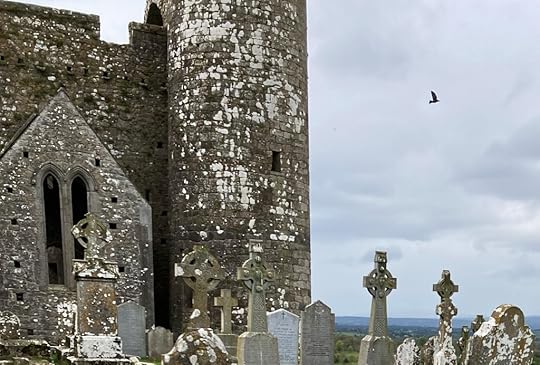
In this companion book I want to share the journey, the joys, and the challenges of my research to offer background for the novels.
So in these gray days some streams of sun shine through and I find purpose. May the promise of yesteryear sustain me. I wish such hope and promise for you, my good readers.
November 18, 2024
November Blues … and Breathing
The dark days of November have come upon us. A darkness that can bring us down.
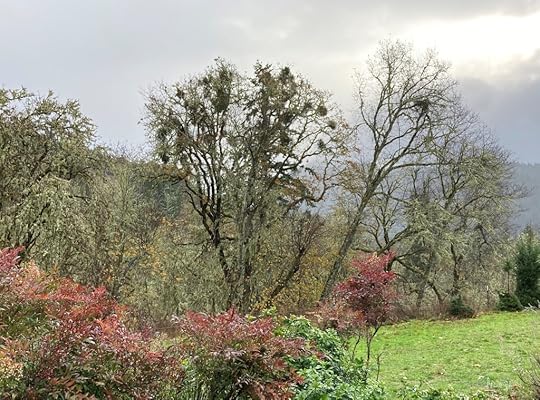
Today the forecast looked like rain all day. Then I glanced up from my morning tea and saw that the sun had come out. Better get my walk in fast. But by the time I got bundled up skies had already darkened again. I grabbed my umbrella and went out anyway.
As I tromped down the road through the drizzle remembering October’s warm sunshine my thoughts turned to the stages of writing–the light and the dark. The spark of inspiration. The thrill of creation. You put so much of yourself into the project. It’s a bit like breathing a long breath out. And it’s such a bright, light feeling. So when that’s done what to do next? Well, I guess you have to take some breaths in. Read. Watch movies. Restore.
After I got back to the house from my drizzly walk I thought I would take a picture of the dreary day–just to reinforce and share my gloom. That’s when I snapped the photo at the top and what do you know. The light just had to shine through those heavy clouds and create a sweeping bright spot. Not for long, though.
Feeling a keen sense of the dark I wrote a draft for this post and when I thought I was finished I looked up and saw that I would have to take another picture. This is what happened.

So there we are. You never know. Out of the dark comes the light. Blue skies. Hope. Inspiration will come again. We’ll find a way through the darkness. Time to breathe in and find peace.
October 1, 2024
Seattle Writing Conference 2024
 Here I am in one of the hotel’s pleasant courtyards near the end of this whirlwind event, feeling happy about all the wonderful connections I made this time.
Here I am in one of the hotel’s pleasant courtyards near the end of this whirlwind event, feeling happy about all the wonderful connections I made this time.Great writing conference in Seattle a little over a week ago. I decided last minute to fly up and attend so I could pitch my new historical novel set in ancient Ireland. I was delighted by the responses from agents I pitched and have now sent off the queries with material they asked for. Fingers crossed. It’s all in the words of course. Hope they love it.
I so enjoy the people at these conferences. Everybody has a story. They are, after all, storytellers. When you meet someone they often ask what you write and you tell the story about that and of course you ask them and hear their story. Attendees also encourage each other. After the pitching begins you share with each other how your pitches went and maybe glean a little information on someone you hope to pitch next. A very upbeat, mutually encouraging atmosphere.
I stopped over in Portland to see family on the way home. One of my daughters just got a new job in Portland and I hadn’t seen the new place yet. Now all my kids are in Oregon for the first time in ten years. I’m so glad. A couple of photos below show views from our walks on a hill overlooking downtown Portland. That’s Mount Hood on the hazy skyline in the second photo.
 Looking down to the Portland city center from the heights near Washington Park.
Looking down to the Portland city center from the heights near Washington Park.
 A city building seems to echo the sharp peak of Mount Hood behind it.
A city building seems to echo the sharp peak of Mount Hood behind it.
August 29, 2024
Martha’s Farm Makes the News
With Martha’s Farm gaining Sesquicentennial status it’s making the front page news.

Drew Winkelmaier, reporter for The News-Review in Roseburg, Oregon, came out to the farm in Kellogg last week and put together a nice story for the Sunday edition.
That’s me on the porch, photo by Drew. We talked awhile then went down to the old barn that has stood on the property since the 1930s when my father bought the place from his great-uncle and had the barn built.
From there we visited the hazelnut orchards, our newest crop on the farm, which had been a prune farm since 1895 when Martha’s son Cap planted the first prune orchard.
With the prune market turning iffy and a burgeoning hazelnut market we began making the switch in 2011 when we planted our first hazelnut trees.
Drew’s story delves into the history from our discussion as well as information I had put together for the Oregon Century Farm and Ranch Program, much of it based on my research for the book I wrote about Martha, A Place of Her Own. When I took over the farm in 2008 I became the second woman to own the place and thought there might be a story in that. And yes, Martha had far more story than I ever imagined.
My family got together at the Oregon State Fair last Saturday, August 24, when fourteen farms were honored for Century status and two, including ours, for Sesquicentennial status. We received lovely certificates at the presentation when short narratives were read about each of the farms with photos on a screen above the stage.
After that we did what everybody does at the state fair. We visited the animals, including a competition among elegant horses in the historic horse barn. And the poultry and pigs and sheep and goats and cattle. Oh, and the beautiful family of huge black draft horses. Such magnificent creatures! And we saw exhibits of photography and artwork and ate too much fair food.

And on the way out we enjoyed strolling through the rides as the skies darkened and the lights came up.
Exciting times for Martha’s farm.
August 14, 2024
Martha’s Farm Approved for Sesquicentennial Status
The Martha A. Maupin Farm which I now own has been approved as a Sesquicentennial Farm, having been in the family for 150 years. In fact it reached the 150-year mark in 2018. Martha purchased the farm in 1868. But this year I finally went through the process of applying for the Sesquicentennial status through the Oregon Century Farm & Ranch Program.
The families approved this year will be honored at a ceremony at the Oregon State Fair this month on Saturday, August 24 at 11 am in the Columbia Hall on the staged area. Fourteen families have been approved for Century status and two for Sesquicentennial status for 2024. Photo highlights for each award winner will be presented at the ceremony with a desert reception afterward.

The photo above shows Martha and her family in their early years on the farm in front of the house she had built soon after her 1868 purchase. That’s Martha standing on the front porch, her eldest son Cap on the horse. Cap became part owner with his brother Tom when their mother sold it to them in 1886. Then Cap became sole owner when he bought his brother’s share in 1894. From Cap it went to my father Eugene Fisher, Cap’s great-nephew, and my mother Marian in 1934, then to my sister Nancy and I, and finally to me when I bought my sister’s share in 2008.
Part of the application involved finding the documents to verify all those transitions, which can be a challenge. I had obtained some documents, like Martha’s original purchase, when I researched my book about her, A Place of Her Own.
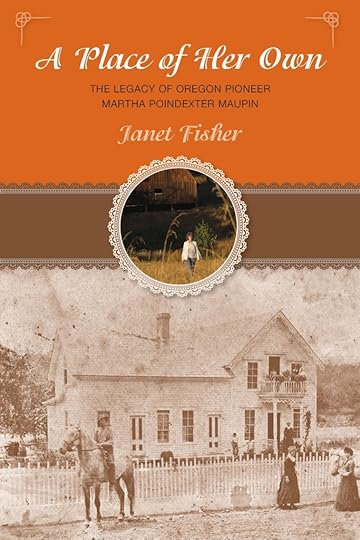
But I was missing some of the documents, which took me back to the Douglas County, Oregon, County Clerk’s office to find the missing links.
The application also required a two- or three-page narrative of family history, including the transfers from one generation to another. My research for the book helped on the early part of that history. Memory served on later events, but I had to scour some local histories and the newfound documents to bring in the middle. The local histories had also helped with my book research.
Martha’s place has been a Century Farm since the 1960s, and I have been pleased to know that this was one of the few Century Farms in Oregon named for a woman, which seemed especially sweet since I’m the second woman to be its sole owner. Now it’s an Oregon Sesquicentennial Farm named for a woman.
I do love history, so it was an intriguing process, and I have a clearer view now of the farm’s history.

The sample of Martha’s purchase document shows the flowery writing one has to pore through in order to glean what you want to know.
In addition to the legal documents and narrative, the application required maps, and requested photos. I also sent a copy of my book about Martha, which the Program Coordinator said they would be very happy to have.
I’m excited to honor my great-great-grandmother Martha for her historic achievement of founding this treasure when it wasn’t easy for a woman to do such a thing.
Below are a couple of photos from the farm, our new hazelnut orchard and the old 1930s barn that still stands on the hillside, looking down to the river bottom. For more on those hazelnuts, see the story here.

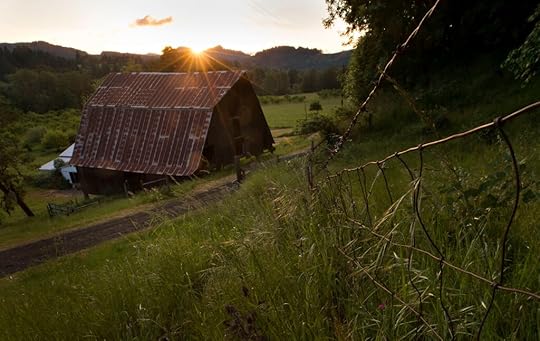 Robin Loznak photo
Robin Loznak photo
June 30, 2024
Going There 2024 – Reflections
Where the story comes to life . . .
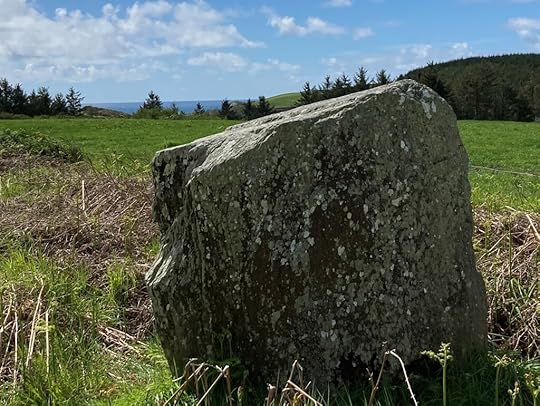
The photo above brings stone and sea together, the upper line of the stone echoing that notch where the sea gleams bright blue when the air is right. This is one of the pillars in the Bohonagh circle near Rosscarbery, Ireland, sacred circle of the protagonist’s clan in my story.
With this last post in my “Going There 2024” series I’d like to reflect on the highlights of my recent trip to immerse myself in the main settings of my upcoming historical novel. More than anywhere I went it was Rosscarbery on the southern coast of Ireland where my story lived. I had time to wander by myself there and let it all soak in.
I passed a few people when I went down to the beach below but for the most part it was a solitary stroll. There I learned about beach grass on that Irish coast–unlike Oregon’s tall beach grass that found its way into my Irish story and has to be replaced with the low grasses I noticed here.
This is why I “go there.” It’s part of my work as an author. To see the places, and feel them, and try to get it right, so I can bring the reader into these worlds with me when they read the words of my books.

My explorations showed me the lay of the land along the bayshore, which will help with my descriptions. The stunning beauty of an afternoon sunlight on the water might come into a scene.

And the circle? There wasn’t another soul where I climbed to the circle and stepped inside to experience it and imagine how it must have been when musicians played and people danced. Or when they came alone to pray, stepping inside through the portal stones, honoring their Great Ancestress, Grand Mother of them all.

The next most critical site where I could feel my story come alive was at Newgrange. The lofty passage tomb with its own partial circle of stones. The incredible passageway where the light of the winter solstice sunrise shines all the way down to the inner chamber with the meticulous corbelled roof, filling it with light.

I learned that the tomb did not lie in front of the ridge as I had described it, but actually crowned the ridge, the back side having sloughed down the hill behind so it covered some of the surrounding kerbstones and standing stones. The archaeologist who restored the monument brought it back as near as possible to what it was when my characters walked down the long, narrow passage into the vault, and I of course thought of them when I walked inside myself.
Back in Dublin I marveled at the goldwork produced during the time of my protagonist, a young woman goldsmith, as I walked through the remarkable array of gold displayed in the National Museum of Ireland – Archaeology. Here’s just one example of a collection there.

On another excursion I saw more clearly the rugged stones of the great rock, the outcrop of the Rock of Cashel that stands bold upon a broad green plain. I could better describe it now after climbing up those knobby limestone walls myself–not the walls built by men on top of the rock but those left by nature long before, the only walls my characters would have seen.

And when I left Ireland for Hallstatt I would see and learn more. Why Hallstatt when my story is about ancient Ireland? Because of the Celts. Yes, when we think of the Celts we may well think of Ireland. But at the time of my story there wouldn’t have been any Celts in Ireland yet. Not in any numbers anyway. Their homeland in 750 B.C. would have been in Hallstatt, Austria. So to bring the Celts into my story we go there. And I followed.
I had visited this remarkable place once before. But with this visit I would refresh my mind’s image of the brilliant water of that lake between steeper slopes and more massive cliffs than I remembered. I thrilled to the play of light on the water. Was it something different in the skies this time? Or the brush of wind that came with unsettled weather? Or was it always so and I forgot?

It took me awhile to find the waterfall I describe in my story. But there it was above the museum, fog hiding the higher slopes.

I reached the falls at last and will show it more clearly now in the description. Back down on the lake’s edge, I got a better sense of the sheer drops on those bold mountains where my characters walk.
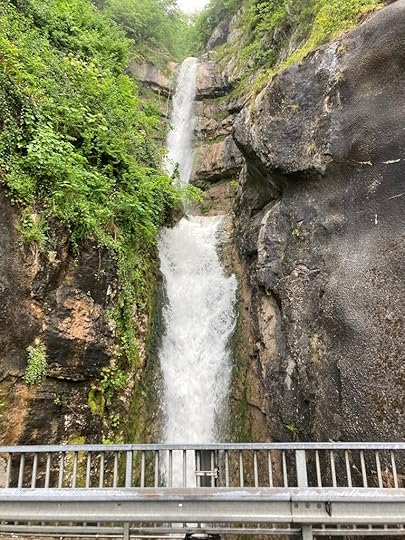
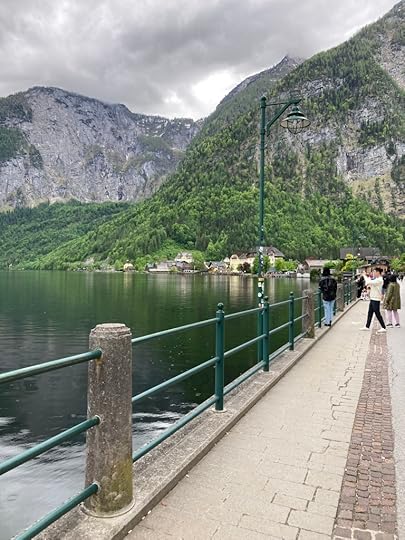
In the Hallstatt Museum I saw a Hallstatt sword, like those I describe in my story. Here’s the real thing, which had been found just up those mountains. I could almost hear the swish of bronze slicing the air.
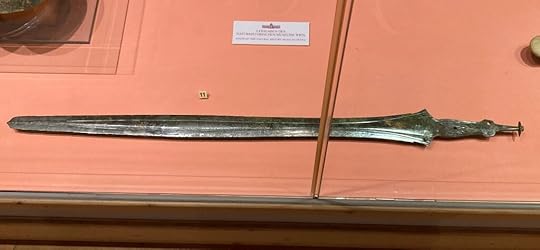
So much. I left these amazing places, my head full of images, words. How to describe? How to take the images from my head and put them into the words that will let the reader see and feel. Ah! The challenge, the joy, for every writer.
Out of the many experiences I had on my trip this spring of 2024, these are the ones that stand out to me, highlights that will surely affect the work. The journey gave me so much. People along the way offered so much. I am ever grateful.
As I continue to absorb the wonder, may these memories reflect in the pages. Story came to life here.
NOTE: This concludes the “2024 Going There” series. I’ll keep the list of titles on the sidebar so you can navigate the stories whenever you might like. I’ve had fun reliving the moments and hope you’ve enjoyed sharing some of them with me. I’ll continue to post snapshots from the trip on social media now and then. I love hearing your thoughts. Thanks so much.
June 25, 2024
Going There #9: Rooms with a View
Yes, of course, there are views, and then there are views. But I have stayed in many a hotel where you’re lucky to have a street to look at. On this trip to Ireland and Austria I stayed in six hotels and five had something interesting out the window. I did not request a view. None of these offered the option.
So, welcome to my tour with a view in mind.
At the Castle Hotel in Dublin my room was on the fourth floor–which meant the fifth, because they start counting one up from the ground floor. A small room, it had all I needed and was fresh and clean. When I peered out the window I smiled.

As buildings go, that was pretty spectacular. It’s the Abbey Presbyterian Church, a stone Gothic Revival structure built in 1862 to 1864. A bird perched on the top right peak as I took the picture, and I later noticed the green nest hunkered below, where birds fluttered in and out from time to time. During my stay when I retreated to the room to put my feet up I took pleasure in the strength of those fine walls and the artistic design. And the birds.
Next stop in Limerick my room at the Old Quarter Townhouse was big enough for a party. It was new and modern–or at least modernized. I looked out the window there and spread my arms, hands uplifted.

There seemed to be a theme here. This one is Saint Michael’s Catholic Church, a limestone structure originally constructed in 1779 to 1781, remodeled in 1805, then rebuilt again in the Italianate style in 1881. This too became a pleasant outlook in the changing lights during my time in Limerick.
On my return to Rosscarbery Catherine O’Sullivan at the familiar Rosalithir B&B happily welcomed me to my newly remodeled room. Everything crisp and bright. And I was so happy to get a front room. The house is on a farm in the middle of green pastures, so all the rooms look out on lovely scenes, framed by the graceful windows and drapes, but the front room looks toward that special notch where the sea glistens blue when the sun is right.


Open the windows and lean out and you see even more.
I peered across the attractive yard wall, past the ancient wall of stone, and out over the wide green pasture to the gap in the bluff that opens to the glimmering sea in the notch. A lovely outlook, much the same as my story characters of the Golden Eagle Clan see from their sacred stone circle, shown below. And from their village one ridge over from the other outlook below, where you can see the gap in the bluff beyond the horse pen.


I felt at home.
In Salzburg I stayed in the guest house in a seminary, Gästehaus im Priesterseminar, which has a historic connection with the adjoining church. Through large windows along the hallway to my room I could see the grand rooftop of that church.

These are domes of the Holy Trinity Church, which borders the seminary on one side, built between 1694 and 1702 to connect with the seminary. So not the view from the room, but from the hall on the way to the room.
From the window in my room I could see this.

It’s the former Palais Überacker built in 1732 by the Counts of Überacker because they wanted a residence close to court, the Mirabell Palace being a very short walk away. It’s just a bank now, but the renovation kept most of the Baroque facade, offering a pleasant outlook from my lovely pristine room.
Last but surely not least was Hallstatt. I knew my hotel there was right on the lake. But not every room could look toward the water. And I didn’t know whether mine would. As noted above there was no option to select a view. So when I stepped into the room my jaw dropped. This was my first sight of the outlook I would have.

The lake! The private deck! I rushed to the door onto the deck and went out.
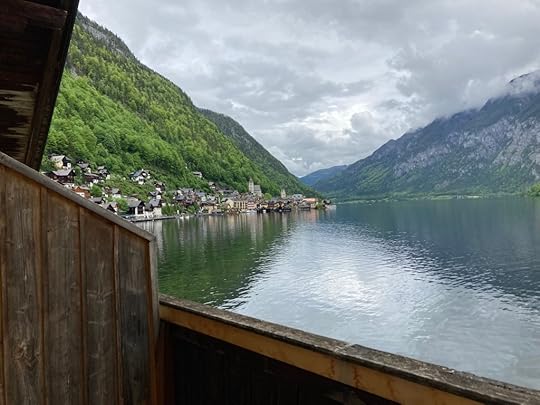
I could see it all. The shimmering water. The fairytale village. The sheer mountains framing the scene. I could see it from my private deck. From my bed. In daylight and dark.

A room with a view. Ah yes. I loved every view. From Dublin to Limerick to Rosscarbery to Salzburg to this of Hallstatt. And I will treasure the memories like a string of cherished jewels.
NEXT: Reflections
June 20, 2024
Going There #8: Hallstatt and the Celts
The enchanted fairytale village of Hallstatt, Austria, is a place you take too many pictures because you keep seeing something new–a different angle, a particular house that seems to drape on the cliffside, a change in the mists. I came here because of the Celts. This was where their ancestors flourished around the time of my new story and I wanted to see it again to better describe it.




When I decided I must have two nights in Hallstatt I tried to cancel the middle two of the four nights I had reserved in Salzburg. The Salzburg reservation, which I made far ahead of time, could be cancelled. The Hallstatt one could not. However I had used a booking company. They told me I had to arrange that with the hotel. The hotel people told me I had to arrange that with the booking company. After going around that circle a few times I decided I would simply have to double book. It turned out to be well worth it.
After I checked into my Salzburg hotel I told the people at the desk that I was going to Hallstatt the next day and asked where to find the bus stop. One of them became quite concerned about me taking the bus. “There are two changes,” she said. That didn’t seem like such a big thing. I looked into it. I could catch Bus 150 a couple blocks from the Salzburg hotel. The 150 would go to Bad Ischl. Bus 542 would soon arrive to take passengers to the next stop, where Bus 543 would pick them up and take them into Hallstatt. How could it be easier?
So the next morning after a lovely breakfast I packed my little backpack with all I needed for the two-night stay in Hallstatt, left the rest of my things in the room at Salzburg with a “Do Not Disturb” sign on the door, and off I went. Caught the 150, which took me to Bad Ischl, end of the line for the 150. But when we passengers got off the bus we found no sign of Bus 542 or any indication when or if it might arrive. Our 150 bus driver came over and said we should take the train. It was better, and we could use our same ticket.
A train was waiting right next to the bus stop with several destinations posted but not Hallstatt. I asked around. No one seemed sure. Finally an elderly lady I guessed to be a local came back from asking and assured me this was the train for Hallstatt. I headed for it and another person said yes, it was the train for Hallstatt. I got on. The train left the station.
I saw a reader board that did have Hallstatt listed but Hallstatt wasn’t lit up like the other stops. I asked the guy across the aisle from me why that would be. He was apparently a local. He had his bicycle with him. He didn’t know. I glanced at the passing scene, wondering. Soon an announcement came over the sound system–in German. The guy with the bicycle nodded and smiled. We would have to get off at the next stop and catch a bus. There was something wrong with the tracks ahead. “Don’t worry,” he said. “I will show you.”
Another one of those angels when I needed one.
He did show me. He led me off the train and toward a waiting bus. A whole busload-size cluster of people moved toward the bus with me. Somebody asked in English if this was the bus to Hallstatt. The bus driver shook his head, answering in English. “I’m not going anywhere.” He was parked. Another bus arrived. The crowd moved as a single thing to that bus, and we asked if he was going to Hallstatt. No. The other bus would take us. We stood looking at each other. What now? Then the first driver cheerfully called out. “Oh, come on. I’ll take you to Hallstatt.” And as one we flowed into the first bus. And he did indeed take us to Hallstatt.
My hotel in Hallstatt was billed more as an apartment than a hotel. It didn’t have a kitchen, but it also didn’t have reception. I was to ask for my key at the Seecafe right next door or use a code on the box if I was late. I got there in plenty of time so a charming young man at the cafe had a key for me. When I walked into my upstairs room and looked out the windows my jaw dropped. The view! And my own private deck!

My hotel/apartment, the Hallstatt Lakeside top 5 Zimmer mit Balkon, was at the south end of the roughly one-mile length of the whole village of Hallstatt. The above photo is the northerly aspect of my view toward the village center. I don’t know much German but I might have guessed that “mit Balkon” meant with balcony. The “top 5” referred to my room.

This next photo shows the view directly across from my deck. Ah! The rippling water, the raw stone mountains, the clouds!
As soon as I dropped off my few belongings I set out to see the town and took the four pictures at the top of this post. And more pictures. And more.
I had been in Hallstatt once before, in 2006, with my friend Tilly, who was from Austria though she had never visited Hallstatt. That was in October when leaves had begun to show color. Now it was May. The weather forecast wasn’t encouraging, but you take it as you find it. I had my umbrella. For now it wasn’t raining and I thrilled to the wonder.
My plan was to explore the village for the rest of this day, take pictures, and locate the waterfall, which plays a role in my story. For some reason I could not find that waterfall. Once I thought I had glimpsed it, but when I looked again I didn’t see it. The next day I planned to visit the museum which I remembered being outstanding. I had a very different story brewing in 2006, one I had since abandoned. This time I wanted to know more about those Hallstatt Celts, or Proto-Celts, who are important in my new story.
The other thing I had hoped to do on my one full day there was to walk the trail up to the High Valley where I had set my Proto-Celtic village near the ancient salt mine. The mine has been in operation for about 7,000 years, going back well before the Celts were there and continuing during their time. I had gone up to the High Valley in 2006, taking the funicular. But it was the trail I wanted to see and describe. I had never been on that trail, and I was deeply disappointed to learn that the trail was closed for renovation. One of those plans I would have to let go.
Before I was quite done with my first day a light sprinkle began. Full of optimism I hadn’t brought out the umbrella or even worn a rain jacket. I hurried back to my room for my umbrella and long raincoat. I was too late for dinner at the nearby Seecafe so I had to walk the mile back to the main village through what had turned into a heavy rain. I found a nice place where I got an unusual but tasty pizza. I’d eaten half by the time I thought to take a picture.

Back at the room, where I could prop up a pillow and lean back on my bed and still see the view, I looked out and saw this.

Magical.
The next morning I headed for the museum and found my waterfall.

See it? Just above the museum rooftop. The museum wasn’t open yet so I searched for a way to the falls, doing my best to ignore a soft drizzle.


I met a friendly guy on the street, vigorously fluffing his white feathers, and one feather wisped onto his bill. Swans own a good portion of the lake–the real and not.
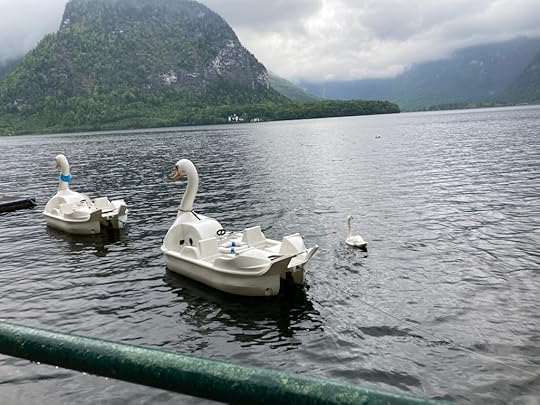
When I started up a staircase I thought I’d been on before I met a family coming down and asked if the falls were up that way. The man didn’t try English but he showed me the translator app on his phone that mentioned the “view.” And a picture with a fine view from up there. I showed him my picture of the distant waterfall above the museum. He nodded and nodded, pointed up the stairs they had come down and said. “Two minutes.”
I soon knew for sure I had been on those stairs the day before but apparently not far enough. You had to go into the edge of a tunnel for cars that hadn’t looked to me like a place for pedestrians. This time I went in and found it was well roped off. The sound of rushing water grew steadily louder. I came out into a parking lot and there was the full view of raging water in two tiers.

For all that power of moving water, I had read that this waterfall freezes solid in the winter. It also does so in my story.
Going back down the hill another way I found more lovely views.
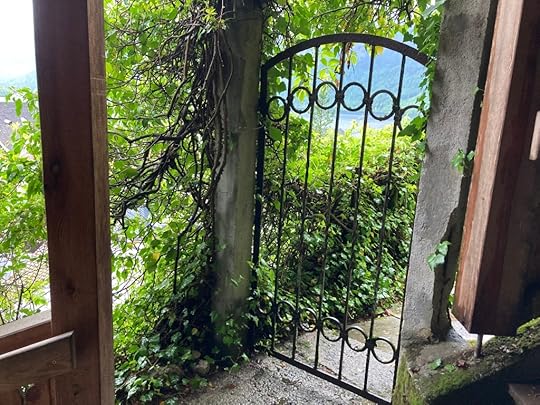

I remembered the Hallstatt Museum for its excellent displays, but it was even better this time. Now I was especially looking for the Celts of course. There were also some good exhibits on the mine. The salt of the mine preserved materials so they know what people wore and the fabrics they wove.
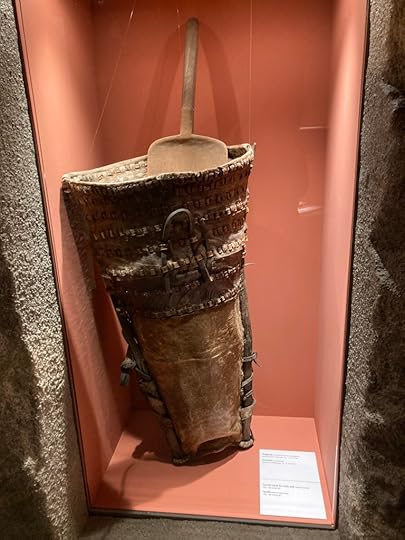

The above photos show a miner’s pack for carrying salt blocks out of the mine and a diorama of a miner himself. From fragments left behind scholars believe the ancient people in the High Valley built their houses of logs, the corners interlocked as in the diorama, the way Oregon pioneers did. There were plenty of nice straight firs in those heights to use for that. I would get that in my story.
A huge necropolis of graves was found for the period 800-750 B.C. (my story opens in 750 B.C.), and many bronze tools and treasures were drawn from these, telling us more about the Proto-Celts. No princes’ graves were found, but the items showed considerable widespread prosperity.

I especially liked the above display of the swirled fibulas in bronze, as well as a bronze necklace. The fibulas were worn by men and women both, probably to pin garments together. The necklace came from a woman’s grave.

And above we have the famous Hallstatt sword in bronze. Note the long leaf shape and the ribbing on the blade. The richest graves contained long swords like this in bronze or iron.
A village on a sheer bluff has many steps. I traipsed across hillside lanes and up and down a lot of steps to get a feel for the slopes and the places my characters would go to appreciate the beauty themselves. That evening I made it to the Seecafe before it closed and ate delicious pesto pasta while still enjoying the view right outside their back door.
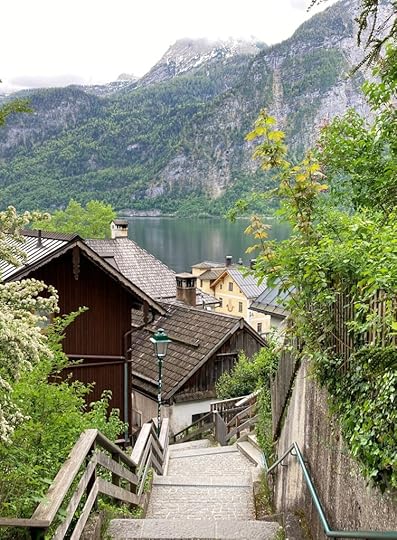
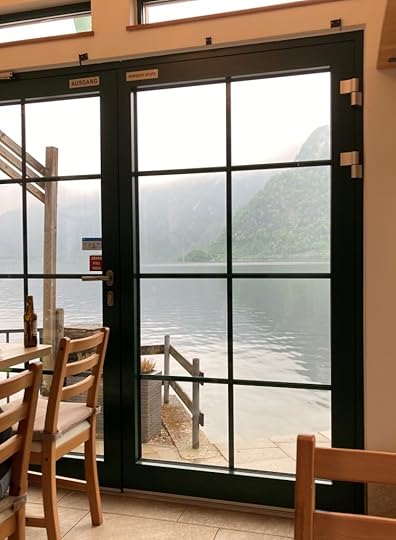
And so, one more look at the village on the southern end beneath the massive limestone mountains and the pretty houses that climb the bluff on that side of town. My room was just beyond the photo to the far left.

The next morning I had to leave this beautiful place. The morning broke with a hope-inspiring light, throwing a sheen on the water’s edge in the southern aspect from my deck view. The surface across the water never appeared quite still.

I would retrace the uncertain way back to Salzburg. It worked. I was glad I left the big bag in Salzburg so I could make all those bus and train transfers with no more than a small backpack and handbag to carry. I absorbed much on my journey into the enchantment of this place, and it will reflect in the work.
NEXT: Rooms with a View
June 17, 2024
Going There #7: Angels
I dedicate this post to my writer friend Elizabeth King. I was telling her about the many times I’ve been rescued by people on my trips just when I needed them most. I call them my angels. She told me about a time she and her husband were traveling and found themselves in a terrible predicament. A man offered to help, and after he resolved everything Elizabeth happened to see the man’s name. His name was Angelo.
~ ~ ~
So, after my wonderful stay in Rosscarbery at Catherine and Finbarr’s B&B, my next stop on this trip was Salzburg. Pictures of the hotel there looked amazing and I was looking forward to that.

It’s a renovated seminary turned into a guest house. The Gästehaus im Priesterseminar. When I saw a picture on a booking site I knew I wanted to stay there. The domes aren’t on the guest house itself, I learned, but on the connected Holy Trinity Church. And while Salzburg itself doesn’t figure in my stories it was close to the more remote Hallstatt, which does.
Salzburg was a long road from Rosscarbery. Bus or train to Dublin, which could take all day. Flight from Dublin to Salzburg the next day with a brief layover in Frankfurt. My concerns about that short layover niggled at me after seeing the confusing monstrosity of the Frankfurt airport on the original flight from home. I flew Lufthansa, a German airline, and their hub was Frankfurt. I likened the place to nightmares where I walk and walk, upstairs, downstairs, around and around, and never find the place I’m looking for.
Even the road to Dublin looked long. I had a return bus ticket as far as Cork, but there I would have to transfer. Catherine recommended a particular bus from Cork. It was faster than others and would let me off on one of those quays in Dublin where I would know exactly where I was and could walk to my hotel up familiar O’Connell Street. However, this bus line didn’t go into the Cork bus station, leaving instead from a simple bus stop across the river. Another of those streetside stops for long-haul buses. She did her best to give me directions, with a map. I hoped I could find it.
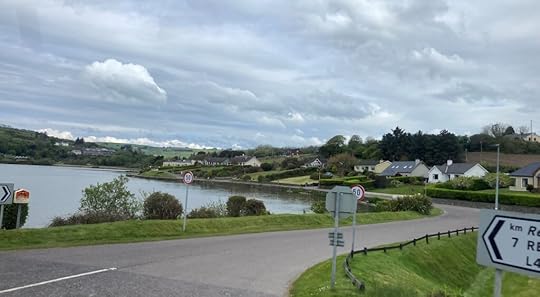
After hugs and warm good-byes I was on my way, looking back from the bus to the lovely lagoon of Rosscarbery, a place of so many memories.
On the way to Cork the bus had several stops. At Bandon a lot of people got on, and a nice-looking woman sat by me. We struck up a conversation. Where are you headed? How are you getting there? That kind of thing. I did express a little concern about the change in Cork. By the time we reached Cork we had covered many subjects, a most enjoyable visit. So when the bus pulled into the station she told me she would show me the way to my next bus stop. Much relieved, I went down to drag my bag out of the luggage bay underneath the bus. I thought she would point me in the right direction.
No. She introduced me to her husband, Dermot, who had taken a seat farther back, and her husband’s brother, John, the brother’s wife, Mary, and told me her own name, Catherine. Another Catherine! They were the O’Donovans and they were headed my way. They didn’t just show me. They escorted me.
They whisked me right through that bus station, out across the street shown below, across the bridge over the River Lee just beyond that street, down the angled lane on the far side that Catherine tried to tell me about, and right to the bus stop I was looking for, chatting and laughing with me all the way.
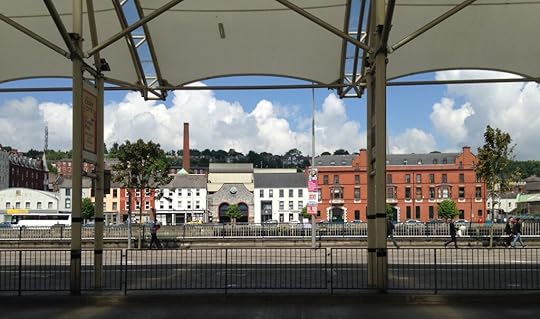 View toward the River Lee from Cork bus station (2018 photo)
View toward the River Lee from Cork bus station (2018 photo)We were exchanging names and contact information when the bus pulled up. Angels. All four O’Donovans. Angels to help me. Just when I needed them.
~ ~ ~
For the next day, second leg of the long road to Salzburg, I had paid extra for a seat near the front on the flight from Dublin to Frankfurt on account of that short layover. My hopes for an early landing didn’t happen, and when the plane did land they drove and drove until I thought we must be circling the entire massive airport. I checked the time when the plane pulled to a stop on the tarmac (not at a gate, but I remembered a bus had picked passengers up on my previous landing there). I had ten minutes until my next plane started boarding. I wasn’t feeling easy.
We waited and waited for the airplane doors to open. Someone announced that they were waiting for somebody to bring the stairs so we could deplane. Then they announced that a stairs had been brought to the rear door so they would start letting people out the back. So much for my seat close to the front. By the time the front door opened it was still quicker for me to go that way. But by then my next flight was boarding. As I left the plane I mentioned that to one of the friendly flight attendants. He smiled. “You’ll make it.” I clung to those words.
When I entered the terminal I came to a crowd of travelers (probably all those people who deplaned from the rear) wending their way through zigzag lines toward Passport Control stations, the lines barely moving. I knew what the expression “her heart sank” means. Worries flooded my mind. Reception at my Salzburg guest house would close at 4 pm. If I didn’t make this flight I would be late and I’d have go through some rigamarole to get my key. Well, I could figure that out. But what if I couldn’t get another flight that day? I would miss my reservation altogether. And I had reserved another room in Hallstatt for the next night and I already had so little time there. I might not get there at all and that was my whole reason for going to Austria.
In my rising despair I exclaimed, “My plane is boarding now!”
Someone heard me and echoed my words. “Her plane is boarding now!” The person made way for me. And the echo continued up the line. “Her plane is boarding now!” And they moved aside, one after the other, each encouraging the next person to make way. “Her plane is boarding now!” And the way opened all through that zigzag line. In moments I had reached the head of the line to the Passport Control stations, and the people ushered me forward. “There’s an open one.”
I went to that station and held out my passport, telling the official, “My plane is boarding now.” But the official in the station shook her head, her voice stern. “I am in control here.” She pointed to someone near me and said to me. “That person is ahead of you. You will wait.” I stepped back, stunned.
But the people were not having it. “Here,” they said. “This one’s open.” They ushered me to a different station and the official there hastily did what she had to do and let me through.
Still, I had so little time before my boarding gate would close. I located the departures board to make sure of my gate and, finding it listed, rushed ahead. Despite my early impressions of this airport I found the usual signage. Like every airport, once you know your gate you just follow the letters to the concourse and then the numbers. I was headed for gate 69. I think it was Z69. I don’t remember now. I didn’t take time to check my phone but about the time I got to the 50s I saw a big clock. I had 5 minutes before my gate closed. The 50s seemed to take forever. When I finally saw my gate 69 it was a long way down the concourse and another clock showed I now had 2 minutes. I wondered if it was even possible to go that far in 2 minutes. I don’t know if I made it in time or if they saw this frantic-looking woman rushing toward them and waited, but they did let me through.
If all those wonderful people hadn’t helped me through Passport Control I would never have made it onto that plane. Angels, yes! So many angels.

I reached my guest house in the seminary in plenty of time and they welcomed me in, one leading me first through the beautiful cloister courtyard.
That night as I lay in my narrow bed in my lovely pristine room, I heaved a sigh. “A whole host of angels came to help me this time.” And sudden tears rose.
NEXT: Hallstatt of the Celts
June 11, 2024
Going There #6: Heart of the Heart
Here on a lonely hill, where silence echoes and all is near forgotten, a memory whispers.
Here the center of my Éireann world lives.
~ ~ ~
If Ireland holds the place as the heart of my stories, and it does, then Rosscarbery on Ireland’s south coast must be the heart of the heart. Just up the hill above that charming town lies this ancient circle of stones, sacred center of the clan of my protagonist. I have named her people the Clan of the Golden Eagle, and this land has been their ancestral home for generations.
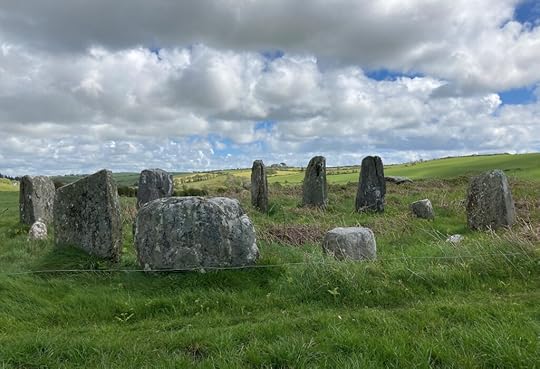
These mysterious circles of stone dating back thousands of years can be found up and down the Atlantic seaboard–across Ireland, Britain, France, Portugal, and Africa. The most famous would be Stonehenge in England. To my knowledge no others bear the horizontal lintels like Stonehenge. The circles range in size. I visited one in Portugal, the Cromlech of Almendres, with almost 100 stones, dating from about 4000 to 6000 B.C. Another, the Castlerigg Circle in northern England set among a ring of mountains, dates from about 3000 B.C.
But this circle of stone caught my heart in ways I can’t explain. It has stood on this hill overlooking the south coast of Ireland since about 1500 B.C., now called Bohonagh Circle. Why these rings of raw stone stand where they do no one today really knows. Scholars believe they marked the passing seasons of the sun. Others suggest they were places of celebration, for dancing and connecting with the gods and goddesses they revered, perhaps places that drew together the powers of earth and sky.

Looking out through the portal stones from inside the circle I felt a sense that I had come home again. A little breathless still, I was looking for better pictures than I’d taken on earlier visits and nature gave me that. The clouds on this day! Oh my! The clouds!
It was more difficult to reach the circle this time. Catherine and Finbarr O’Sullivan, my wonderful hosts at the Rosalithir B&B in Rosscarbery, mentioned that someone was building a house down by the gate that accessed the site. My first morning with them I set out to walk there. Catherine sent me off with a snack of her delicious soda bread and some fruit and I remembered Finbarr telling me that the circle is a national treasure so surrounding landowners cannot keep people out. They don’t have to make it easy, though. This was my third visit with Catherine and Finbarr. They weren’t just hosts. They were friends now.
On my first trip to Rosscarbery a small sign had been posted on that gate below the circle, warning about the “bullocks” in the field and Finbarr had assured me there were no bullocks. Landowners just wanted to scare off visitors. This time there was a huge sign on the gate, which offered strong language about staying out on account of the construction. No one was at the construction site and I had no intention of bothering that. I was going to visit the national treasure. I ignored the sign.
It was a new gate with round bars that didn’t offer firm footing when I climbed, but I hung on tight and made it over. Then I faced a two-wire gate. Hot wires like many on my own farm. I carefully gripped one of the handles and tried to open it but it was so tight I didn’t have the physical strength to budge it. Nothing else to do. I got down on my belly and crawled under, keeping as low as I could.
An easy, familiar track led up the hill then, but to get into the field where the circle stood I had more hot wires to scoot under. At the circle itself a perimeter wire had drooped so low it wasn’t possible to go under. I had to step over, which I don’t like to do because if I wobbled–well, the wire won’t kill you but it sure wouldn’t feel good. I made it inside without touching it.

I stayed and wandered in and out, soaking in the feel of the circle, the surroundings. I especially like the way one stone sits in line with a slope of the vee that opens to the blue sea in the distance. I don’t think that was by accident. Clouds kept boiling in, adding to a sense of awe. After touching each stone with the reverence such a place evokes, I finally walked away, my heart full. On the way downhill I stopped to look back, wondering if I would ever see them again.

The sight of them beneath the towering clouds nearly took my breath.
~ ~ ~
Another day I went down to the bay below the circle, called by my protagonist’s clan their Golden Eagle Bay. Today’s Rosscarbery Bay. I still had questions about the beach. And what’s more, this visit revealed answers to questions I didn’t even know to ask. That made my return particularly important. On my first trip I had traipsed around the shoreline but memory and tiny photos didn’t offer a good sense of the lay of the land there. The few minutes I had on that beach last visit only confused me further. This time I spent a full day exploring the shore.
I had a fairly good sense of the western headland, but I was unsure of the east side of the bay. When I stepped out on a rocky point at the east side of a strand where I thought the bay ended, the point felt way too small for some of the scenes I had written.

There were some good rocky outlying islands to crack up a ship, but there was no room for a battle scene. It wasn’t until I climbed partway up the newly improved Cliff Walk over the western headland that I could look back and see it clearly.
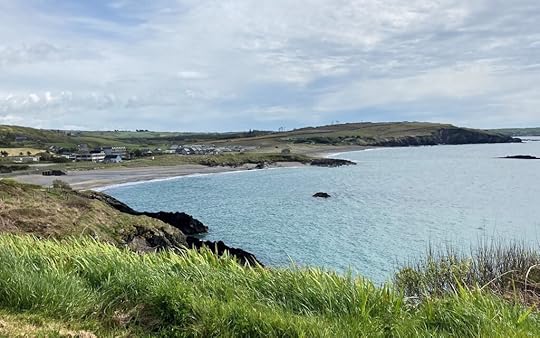
The photo above shows it. That little rocky point jutting into the bay wasn’t big enough to call a headland at all. It did break up two strands, which have separate names today, Owenahincha Strand on the near side from where I took the picture and Little Island Strand on the other. But the photo also shows the only point that could reasonably be called a headland on the east side, a long and bold promontory reaching deep into the bay–beyond the second strand. It’s called today Cloghna Head. Together with the headland where I stood, these are the arms that embrace the full bay.
I continued my stroll over the Cliff Walk to the next beach, mulling all this over. It’s a beautiful walk, with nice new wooden railing and some paving, overlooking broad stretches of water and a small woodland full of bluebells.
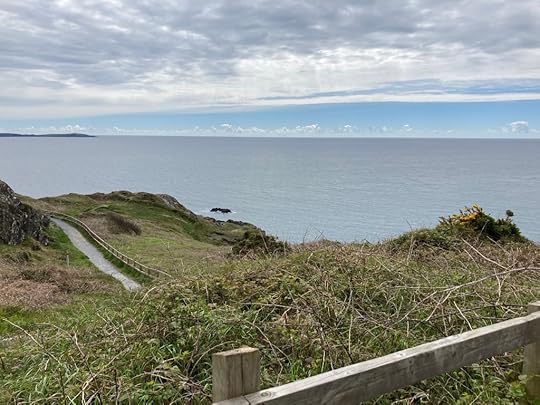

I had planned to call Finbarr to pick me up on that next beach when I was done with the Cliff Walk, as he’d suggested. He and Catherine insisted they drive me to and from the beach because they didn’t want me to walk across the dangerous highway that separated it from the B&B. But now I knew I had to go back to where I started and check out the bold promontory of Cloghna Head, which I now saw was the eastern headland of the full bay.
As I trekked over the grass above the bayshore toward that eastern headland I became aware of something quite unfamiliar. I had walked along sandy trails cut through the grass but I happened to step onto the grass itself. My foot didn’t sink deep into the thick grass as expected but teetered on a thick spongy mass of interlaced grasses. I had never experienced anything quite like it. Because I couldn’t maintain a solid stride I quickly moved back onto one of the sand trails people had cut into that thick mass.
I later mentioned this to Finbarr and he said that’s the way beach grass grows there. It helps prevent erosion along the beaches. I told him on the Oregon coast we had tall grasses along the sandy shore. He said that those tall grasses perform the same function. And I, knowing tall grasses, had written such shores into my Irish beaches. I would need to take out that tall grass in my stories in many places. You need to get it right for the locals. And I almost didn’t.

I walked close to Cloghna head to get a better sense of it but didn’t walk onto the top. I was particularly interested in those sheer cliffs down to the jagged rocks below and how they might work into a dramatic scene. I didn’t think about the grass on that promontory until later. But Finbarr assured me that the broad grassy top there also has the thick spongy beach grass. Other grass, away from the shore, he called pasture grass. As a farmer, raising cattle, he knew these things. I was so glad he cleared that up for me.
~ ~ ~
I would take more walks during my visit, got lost once on a rainy walk, then came upon the B&B quite by surprise. Irish luck again. And I explored several back roads, meeting horses and dogs and friendly people, including Tara and her beautiful Irish Cob mare with the distinctive feathering above the hooves–named Sootie for her black coat, Tara said.


With each walk, each day, I got a better sense of the place that I knew would show up in my descriptions. And my memories. Helping my Éireann world live. A wondrous visit to a wonderful place.
NEXT: Angels



